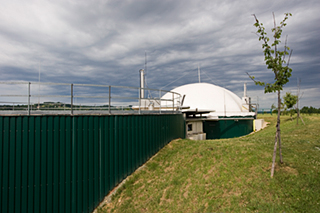Biomethane
Biogas in the tank
Biogas is obtained by fermentation of hydrous biomass, agricultural residues such as liquid manure and dung or from organic residues in biogas plants under exclusion of oxygen. Through upgrading of the raw biogas the fuel biomethane is produced.
The water-saturated raw biogas is mainly consisting of methane. Further important components are carbon dioxide, nitrogen, hydrogen sulphide, hydrogen and ammonia. Most of these substances are removed in the upgrading process. Depending on the feedstock the methane content of the raw biogas is alternating and is concentrated up to 100% during the biogas upgrading. Biomethane can be used as fuel within a combined heat and power plant as well as for vehicle engines, which are adapted for natural gas.
Principally all fermentable waste materials are suitable for fermentation, such as sewage sludge or biodegradable waste, liquid manure or animal droppings as well as specially cultivated energy crops. Crucial is the methane content, which lies between 50-70% depending on the raw material.
Prior to upgrading the biogas is a water-saturated mixture of gases from miscellaneous substances. The individual by-products would cause various problems during usage. E.g. the water content leads to condensation which is problematic for the vehicle engine as well as for the pipes within the combined heat and power plants.
After a partly upgrading (removal of H2O and H2S) the biogas can be used directly in combined heat and power plants or in gas burners. Another option is the further upgrading to biomethan, which consists of nearly 100% methane.
In a first upgrading step hydrogen sulphide (H2S) is removed. This could be done by the addition of air to the fermenter which forces the microorganisms to divide hydrogen sulphide into hydrogen and sulphur, or it could be done by external desulphurization.
The water removal occurs by cooling of the gas, whereby the steam condenses and can be removed. Due to the fact that ammonia is water-soluble, it can be separated together with the steam. In the end the share of carbon dioxide has to be minimized, which is feasible e.g. through membrane separation method or absorption processes. After upgrading the biomethane is similar to natural gas and can be used in combined heat and power plants or combusted in vehicles.
Biomethane and the climate
Biomethane is a biogenic fuel, obtained from waste products such as biodegradable waste or liquid manure and dung. The fermentation processes, running in the digesters in biogas plants, are happening like in nature.
Metaphorically speaking cows are small biogas plants – they are producing around 100 litre of methane per day.
Apart from the existing raw material potential methane is twenty times more harmful to the climate than carbon dioxide. If that part of methane which is arising anyway through natural process and various waste products, is burned to carbon dioxide, then on the one hand it reduces the climate-damaging effect of the resulting gases and on the other hand energy is produced.
Biomethane, obtained from energy crops, shows a closed CO2-cycle. That means the combustion of the automotive fuel is CO2-neutral.
Biogas and Austria
Biogas is used in Austria in particular in combined heat and power plants for electric power generation. In February 2010 there were 344 biogas plants listed with in total had a maximum capacity of 93.4 MW. About 525 GWh are obtained through biogas conversion into electricity. The amount of energy is increasing by 44 GWh on sewage and landfill gas converted into electricity.
In 2005 the first local biogas plant became operational in Upper Austria, obtaining Biogas from animal husbandry, upgrading it to biomethane and feeding it to the Austrian natural gas grid. After biogas upgrading the plant in Pucking is yielding 6m3 per hour, achieving the quality norm for natural gas. Therefore an annual capacity of 400.000 kWh is arising, which means that 40 apartments could be supplied with electricity. Additionally 108 tons of CO2 can be saved.

Biogas plant
(c) BIOENERGY 2020+

